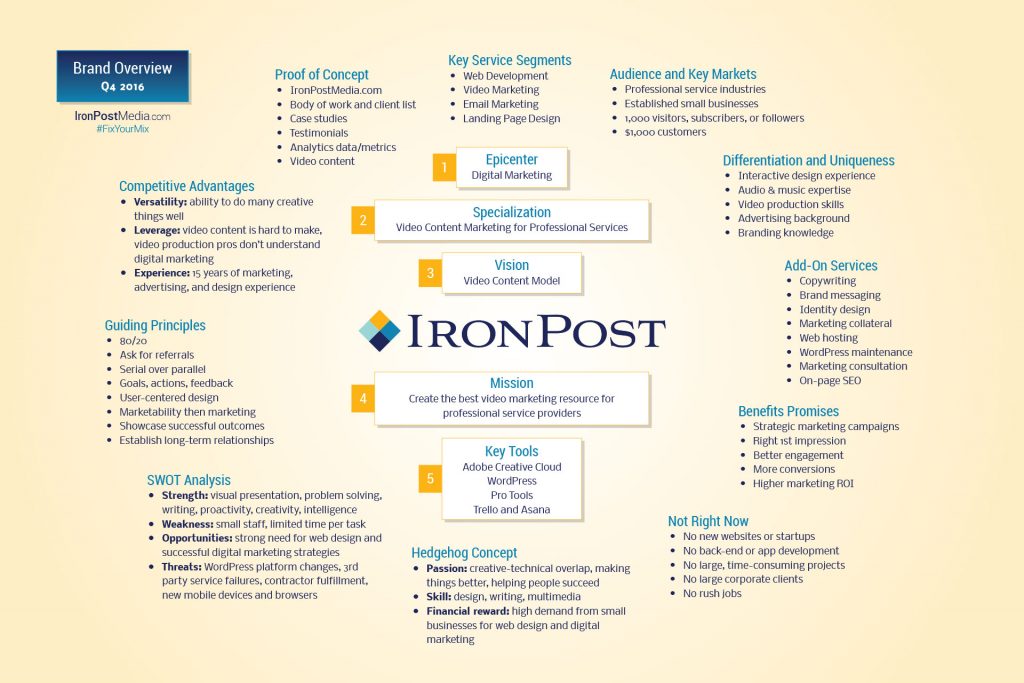Guiding Principles
Branding is a big, fuzzy topic. You can find endless definitions of branding with limitless examples of tactical branding exercises. Over the years I’ve tried to move away from the fuzziness. I’ve made an effort to condense my brand into a single document.
So I designed a simple Brand Overview document that’s merely a collection of descriptive lists. I revisit it once a quarter and it keeps me on track. It’s also useful for brainstorming marketing and content ideas (brand-driven, strategic, etc.).
One of my Brand Overview lists is called “Guiding Principles.” Near the top of the list is a rather non-descriptive entry: Goals, Actions, Feedback. It’s probably the most important branding concept that affects my day-to-day. It reminds me of the value of feedback in my project management process.
Goals: Problem and Solution
Most people think of goals as an end result, something positive that’s accomplished in the future. That’s not exactly how I approach goals from a creative perspective. When I’m working with goals, they’re not in the future. They’re an early input in the Discovery phase of a project. Goals include the problem that I’m trying to solve as well as the solution.
Defining the problem is huge. If a problem isn’t defined, it’s difficult to judge the effectiveness or likelihood of a potential solution. For example, someone wouldn’t have a weight loss goal if there weren’t a perceived problem. In this case, the solution isn’t “losing weight,” the solution is an ideal weight. The act of losing weight comes after an ideal weight is established.
Actions: Strategy and Execution
Goals are all about the “What” without focusing on the realities of “How” to execute them. The “How” is where most actions coms into play. Action is the combination of strategy and execution. The majority of people focus on tactical execution first, without having an explicit strategy (as if strategy were somehow melted into the initial goals). That’s a mistake. A good strategy is necessary for proper execution.
Back to the weight loss example: drawing up a fitness and nutrition plan is a lot different than jogging or eating vegetables. Planning is a strategic exercise that outlines what you need to do for results. Executing the plan is entirely based on your strategy. Without strategy, action is just activity that may or may not keep you on course. But that’s a bit obvious and not the point I’m driving to.
Feedback: Review and Insight
The biggest mistake you can make is jumping into action without identifying your goals or thinking about strategy (acting without thinking). The second biggest mistake is failure to review the results of your actions. Feedback is an essential piece of the puzzle. It includes reviewing your work and gaining insights for future success. Getting feedback is how you gain quality and get better over time.
First of all, if you’re doing a lousy job of reviewing your work, it’s suffering right now. Reviewing your work impacts your current project. Some might call this quality control, quality assurance or QA. It doesn’t matter what it’s called as long as it gets done. Spell check. Double-check your work. Look at it from multiple perspectives. Get feedback from others before publishing and moving on. All self-evident stuff that gets skipped way too often.
What isn’t so glaringly obvious is the impact your current project will have on your next. Future insight is born at the end of your current project. And it definitely feels like an “extra” step. When you’re finished with a large project, the last thing you want to do is spend more energy analyzing what went right and what could have been better. But the effort is well spent.
Writing a Pre-Mortem
If you’re involved in project work and you’ve never written a “post-mortem” report, I highly recommend giving it a shot. A post-mortem is just an analysis of what happened in a project. They’re best done within a week of completing a project (otherwise our memories have a tendency of getting creative).
The trick to really getting something out of a post-mortem is to view it as a “pre-mortem” for your next project. A pre-mortem is far more useful than a post-mortem. If you’re like me, you’re more likely to take action when you can see it impacting the future. Reviewing recent post-mortems prior to beginning a new project drastically improves project management (and general professionalism). The insights generated from past projects have an amazing positive effect on how you approach your next project. They make you better. “Getting better” brings me back to branding and guiding principles.
An aspect of my brand is focused on continual improvement. It’s a guiding principle (probably why I prefer website redesign over original projects). I’ve developed a project management approach that’s based on this. It’s a concrete example of how branding influences day-to-day operations. I believe “the fortune is in the feedback” and it’s that belief that nudges me to go the extra mile at the end of a project. It’s the extra mile now that gives me the insight to make my next project my best project.









